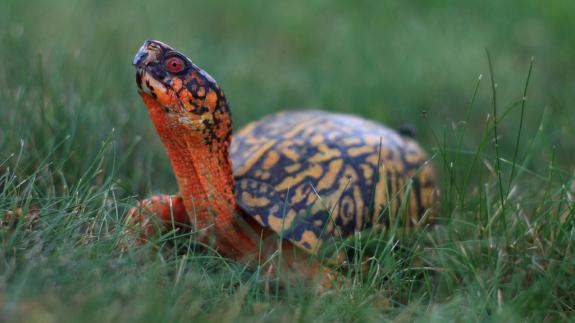Eastern Box Turtle
The eastern box turtle is a very well known turtle in New Jersey, however in recent years their population has been in decline.
The eastern box turtle (Terrapene carolina carolina) is a very well known turtle in New Jersey. They are unmistakable for their bright coloration and unique shell. They are the most terrestrial turtle found in the Garden State. Box turtles range in length from only 4″ up to 8.5″. Its carapace (top of shell) is high and shaped like a dome. The plastron (bottom of shell) is hinged and can close very tightly, in front and in rear. This is meant to protect the turtle from predators, especially the neighborhood dog.
 Male box turtles can be identified by their red eyes. © Ben Wurst
Male box turtles can be identified by their red eyes. © Ben Wurst
Sexes are slightly similar in appearance. Both have yellow, orange, olive, or tan on their carapace and plastron that is contrasted by a light or dark black background. Individuals can appear very different in coloration. The male is very vibrantly colored. Younger turtles are more vibrantly colored than older ones. The plastron of males is slightly concave. The plastron in females is flat.
The eastern box turtle occurs in the eastern United States from central Maine south to southern Georgia and Alabama and west into Wisconsin and Illinois. It can be found in all of the 21 counties in New Jersey. Box turtles inhabit open woodlands and meadows. They are often seen in neighborhood backyards in rural and suburban areas. They are usually not far from streams or ponds, however, during rainy weather they may roam farther from water. They like water, but are not adapted for swimming in water.
Box turtles have very small home ranges. Researchers found that their territories are around 250 square yards or less. If box turtles are removed from their territories and placed in an unfamiliar area, then they may die while trying to find their way back home. It is very important to not take a box turtle from its habitat and relocate it. If you find an injured one and do transport it to a state certified rehabilitator; record the animals location and make sure to inform the rehabilitator so it can be re-released where it was found.
Box turtles are omnivores. Changes in food preference occur during different seasons and life stages. Young turtles eat more insects, while adults eat more plant matter. Young turtles eat earthworms, snails, insect larvae, and some vegetative matter. Adults eat large quantities of fungi and particularly like berries and fruits from trees and shrubs.
Box turtles are cold-blooded and in the northern parts of their range hibernate from late October until April. They burrow into loose soil, vegetative debris, and/or loose sand, and sometimes in the mud of stream bottoms. Some hibernate at depths up to two feet deep. They can arise during warm spells.
Individuals become reproductive at 4 to 5 years in age. They can live up to 20 years in the wild. Mating begins shortly after individuals emerge from hibernation. Eggs are laid in June and July. Females deposit eggs in a hole that she digs in loose or sandy soil and sometimes in lawns. They lay between 2 to 7 eggs. Most hatching occurs in September. Young either remain in the nest after hatching, emerge and go directly into hibernation, or emerge and explore for a few days to weeks, then hibernate. They do not require food during their first summer or fall before going into hibernation.
 Zoom+ Box turtles are easily identified by their bright coloration and unique shell. © Ben Wurst
Zoom+ Box turtles are easily identified by their bright coloration and unique shell. © Ben Wurst
Box turtles are fairly common throughout their range; however, their population is declining in New Jersey. Habitat destruction and fragmentation isolate individuals from finding mates and food. This causes local populations to decline or become extirpated from an area. Their slow reproductive rate does not allow for a fast recovery if a local population looses several individuals in a given amount of time. They are also highly sought for their use in the illegal pet trade. Many people illegally collect box turtles to breed in captivity for use as pets. Another conservation concern is the impact of high mortality rates from impacts with motor vehicles. Many roads transect suitable habitat for box turtles and many turtles that enter roadways die each year. These threats have exacerbated their decline and due to that fact the Endangered and Nongame Species Program (ENSP) has listed them as a Species of Special Concern. This listing will most importantly help garner protection through enhanced habitat protection of suitable or critical habitat for box turtles.
There are several things that you can do to help conserve box turtles in New Jersey. Drive carefully and look out for them on roadways. If you stop to help them cross a road, make sure to put them in the direction they are heading. Report your sightings of box turtles to the ENSP using a Sighting Report Form. And most importantly, leave them where you found them!
By Ben Wurst, Habitat Program Manager
Find Related Info: Reptiles






